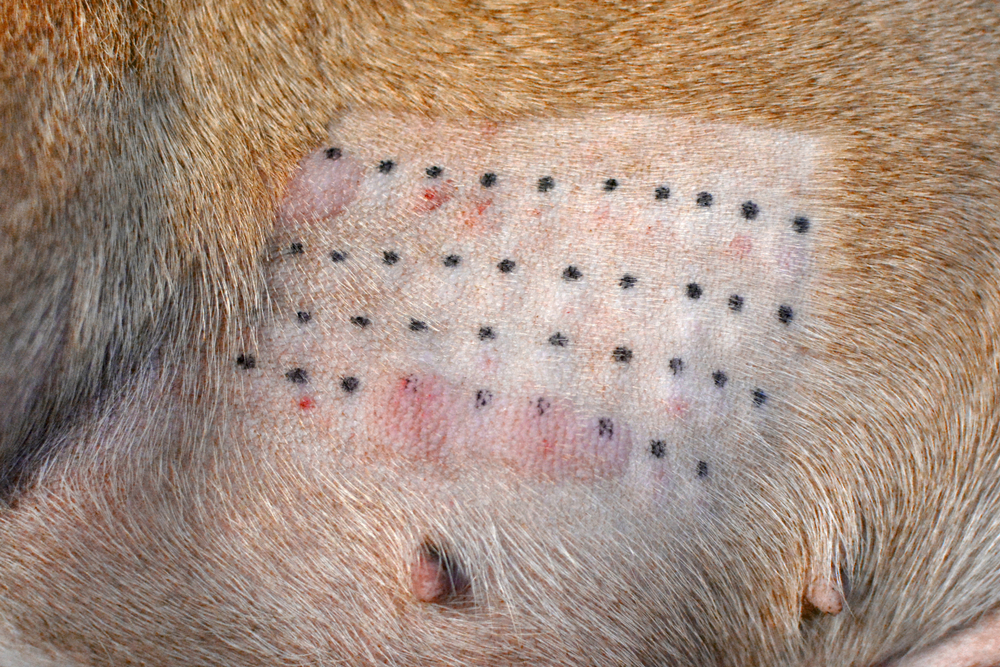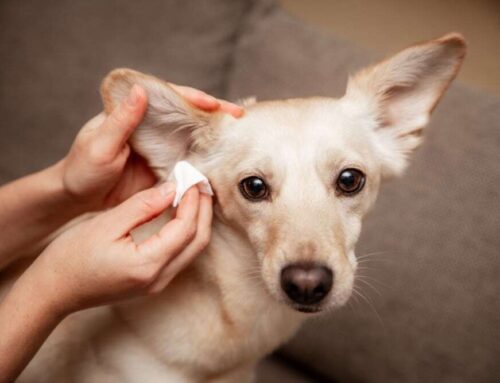Your pet may not have a runny nose or watery eyes, but they may still have allergies. Many allergens can cause pets to react, and pet allergies can be difficult to manage. Our team at Animal Medical Hospital of Naples wants to help by providing information about common pet allergies.
Pets can be allergic to fleas
A hypersensitivity to flea saliva is the most common allergy seen in pets. These tiny parasites can cause a major reaction, resulting in excessive itching, and the bite from one flea is all that’s needed to cause your pet significant distress. Signs include obsessive scratching, licking, chewing, and rubbing as your pet attempts to rid themselves of the irritating parasites. In addition, they may have crusty skin lesions on their abdomen and groin, and hair loss at the base of their tail. Finding a flea on a pet who is exhibiting these signs indicates that they have a flea bite allergy, but the excessive grooming may make this difficult. The presence of small black specks, which is flea dirt, in your pet’s coat or on their bedding can also indicate they have a flea bite allergy. Treatment involves:
- Removing the fleas from your pet — Bathe your pet, and use a flea comb to remove all the fleas from your pet’s coat.
- Removing the fleas from your pet’s environment — Wash or discard your pet’s bedding, and vacuum all home areas. You should also use an insecticide that will kill the adult fleas, as well as the eggs and larvae. Don’t forget to treat your lawn during the extermination process.
- Providing year-round flea prevention — Your pet will need to remain on a year-round flea preventive to prevent another reaction.
Pets can be allergic to their food
Your pet can also be allergic to ingredients in their food, most commonly the protein source. Common allergens include beef, dairy, egg, chicken, lamb, and pork, and pets can be allergic to more than one ingredient. Affected pets typically have itchy skin, especially their feet, and chronic ear infections are also common. Gastrointestinal problems, such as diarrhea and chronic gas, may occur, but these signs are less common than skin problems. If your pet is exhibiting suspicious signs but no fleas can be found, a food elimination trial may be recommended.
- Your pet will be switched to a special diet — Your pet will have to eat a special diet that includes ingredients they have never eaten before for about six to eight weeks. Another option is a hydrolyzed diet, which involves breaking the protein down to such a small size that your pet’s immune system doesn’t recognize the ingredient. During this food trial, your pet must not eat any treats or medicated chews that contain ingredients they’ve eaten before.
- Your pet will return to their original diet — If your pet’s signs resolve, they will be returned to their original diet to verify they have a food allergy. If their signs return when they start back on their original diet, they have a food allergy.
- Your pet will be challenged with ingredients — Your pet will be placed back on the special diet, and once their signs have resolved, they will be challenged with ingredients in their original diet, to determine the cause of their allergy.
- Your pet will never eat that ingredient again — To prevent a recurrence, you should ensure your pet never eats that ingredient again.
Pets can be allergic to environmental allergens

Pets can also be allergic to environmental allergens, such as pollen, mold, dust, and pet dander. When these allergens cause skin disease, the condition is referred to as atopic dermatitis, which is the second most common allergy seen in pets. Signs are similar to other allergy types, and involve excessive scratching, grooming, and chewing. Commonly affected areas include the ears, feet, abdomen, muzzle, armpits, groin, base of the tail, and around the eyes. Atopy can be definitively diagnosed with intradermal allergy testing (IDAT) or blood testing, although mild cases are often treated with medications to control clinical signs, with improvement yielding a presumptive diagnosis. Treatment is multifactorial.
- Bathing — Weekly bathing can remove allergens from your pet’s skin and help reduce signs.
- Steroids — Steroids are commonly used to decrease your pet’s skin irritation and inflammation. These medications can cause harm when used long term, and should be administered at their lowest effective dose.
- Anti-itch medications — Numerous anti-itch medications are available to help relieve your pet’s distress.
- Hyposensitization therapy — The gold standard treatment for atopic pets is hyposensitization therapy, which involves allergy testing by intradermal skin tests or blood tests, to determine what allergens are causing your pet to respond. This information is used to create a treatment that will involve administration of gradually increasing doses of the allergen, to hyposensitize your pet to the problematic allergens. This method is helpful in up to 75% of pets.
Many substances can cause your pet’s allergic reaction, and the causative agent must be determined to properly address their problem. If your pet is experiencing excessively itchy skin, contact our team at Animal Medical Hospital of Naples, so we can diagnose and help manage their condition.







Leave A Comment